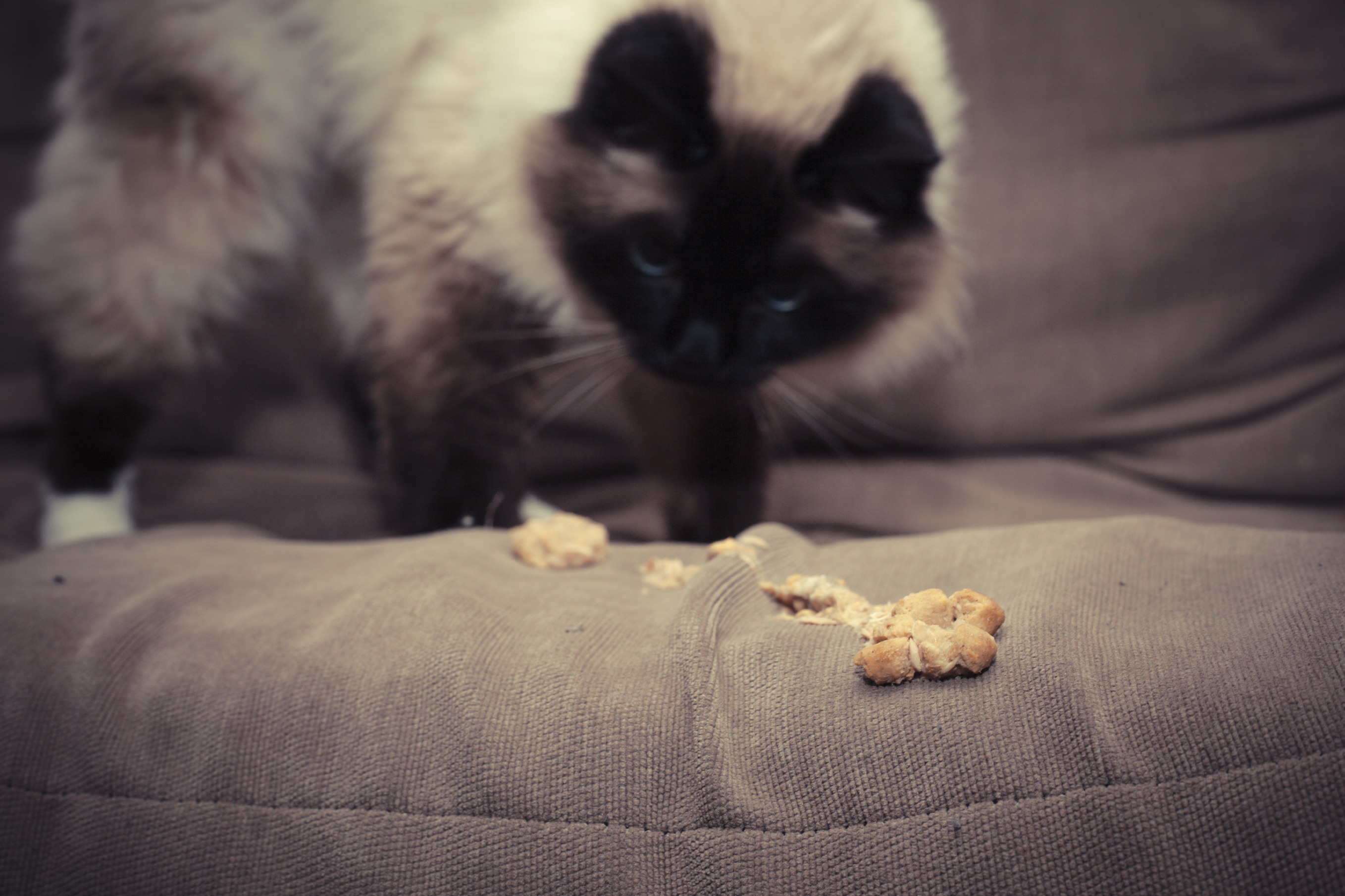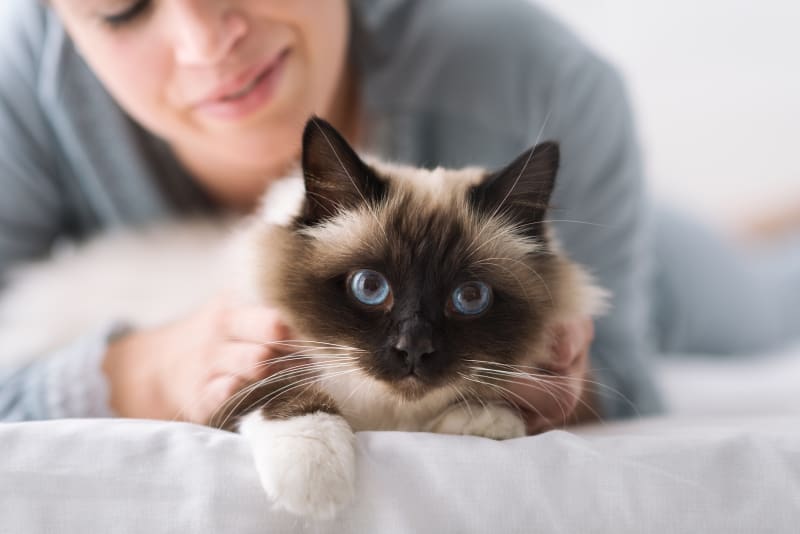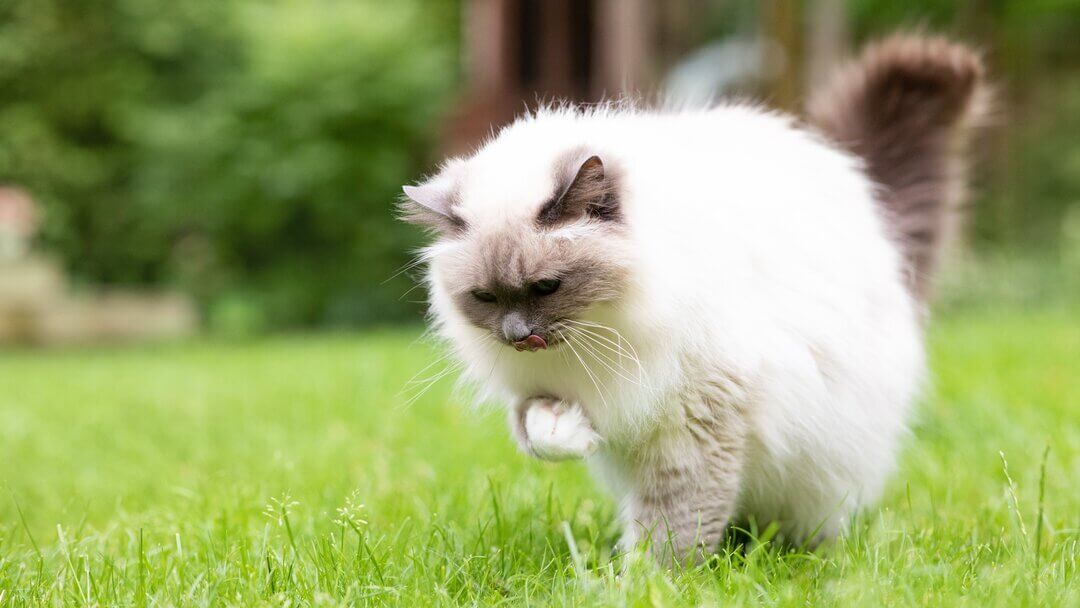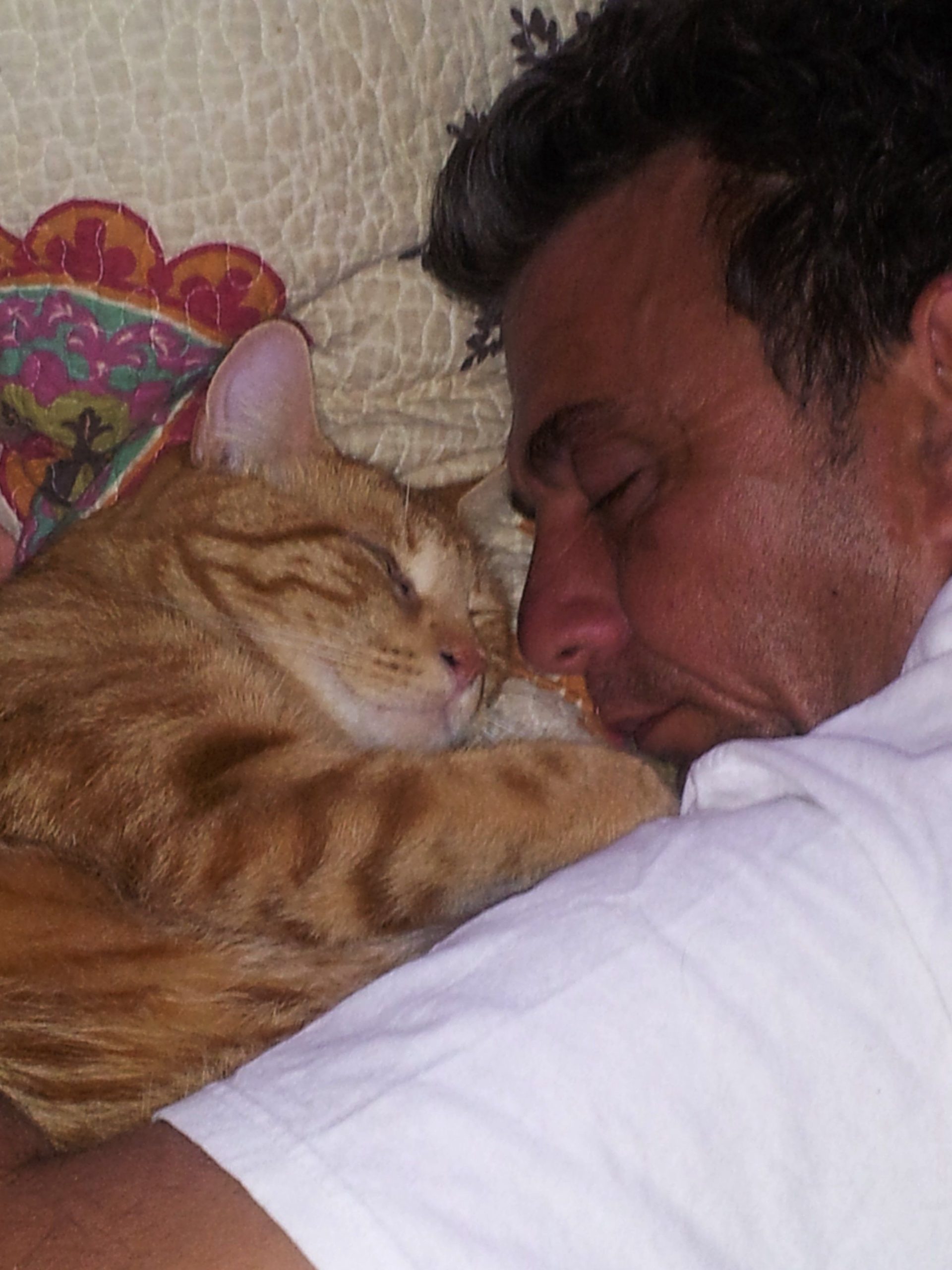Contents
- I. Introduction to Ragdoll Cats and Vomiting
- II. Common Causes of Vomiting in Ragdoll Cats
- III. Understanding the Digestive System of Ragdoll Cats
- IV. How to Identify if Your Ragdoll Cat’s Vomiting is Serious
- V. Steps to Help Prevent Vomiting in Ragdoll Cats
- VI. Tips for Managing Vomiting in Ragdoll Cats at Home
- VII. Frequently Asked Questions about Ragdoll Cats and Vomiting
- 1. Why does my ragdoll cat vomit frequently?
- 2. How can I prevent my ragdoll cat from vomiting hairballs?
- 3. Are there any specific foods that can cause vomiting in ragdoll cats?
- 4. Can stress or anxiety lead to vomiting in ragdoll cats?
- 5. Is occasional vomiting normal for ragdoll cats?
- 6. Are there any home remedies to soothe an upset stomach in ragdoll cats?
- 7. Can certain medications cause vomiting in ragdoll cats?
- 8. When should I be concerned about my ragdoll cat’s vomiting?
I. Introduction to Ragdoll Cats and Vomiting

Ragdoll cats are beloved for their stunning appearance and gentle nature. These adorable felines have captured the hearts of cat lovers around the world. However, like any other breed, Ragdoll cats may experience health issues, one of which is vomiting. It can be concerning for cat owners to witness their furry friends throwing up, and it is important to understand the reasons behind this behavior.
1. Understanding the Nature of Ragdoll Cats
Ragdoll cats are known for their docile and relaxed temperament. They are often referred to as “puppy-like” cats due to their friendly and sociable nature. These cats enjoy being around people and are particularly fond of their human companions. Ragdoll cats are also known for their striking blue eyes and semi-long fur, which requires regular grooming.
2. Common Causes of Vomiting in Ragdoll Cats
Vomiting in Ragdoll cats can occur due to various reasons. Some common causes include:
A. Dietary Issues: Ragdoll cats, like any other breed, can have sensitive stomachs. Certain food ingredients or sudden changes in their diet can lead to digestive upset and subsequent vomiting.
B. Hairballs: Ragdoll cats have long fur that requires regular brushing and grooming. They are prone to developing hairballs, which can cause discomfort and trigger vomiting.
C. Foreign Objects: Curious by nature, Ragdoll cats may come into contact with foreign objects that are not meant to be ingested. This can lead to vomiting as their bodies attempt to expel the foreign material.
D. Gastrointestinal Disorders: Just like humans, cats can experience various gastrointestinal disorders that result in vomiting. Conditions such as gastritis, pancreatitis, or inflammatory bowel disease can affect Ragdoll cats.
3. When to Seek Veterinary Care
While occasional vomiting may not be cause for immediate concern, it is essential to monitor your Ragdoll cat’s overall health and behavior. If the vomiting persists or is accompanied by other symptoms such as loss of appetite, lethargy, or unusual behavior, it is recommended to consult a veterinarian. A professional evaluation can help determine the underlying cause and provide appropriate treatment.
II. Common Causes of Vomiting in Ragdoll Cats

When it comes to Ragdoll cats, vomiting can be a common occurrence. While occasional vomiting may not be a cause for concern, frequent or persistent vomiting can be a sign of an underlying health issue. Understanding the common causes of vomiting in Ragdoll cats can help you identify the problem and take appropriate action.
Dietary Issues
One of the most common causes of vomiting in Ragdoll cats is dietary issues. Cats can have sensitive stomachs, and certain foods or ingredients may not agree with them. If you recently changed your cat’s diet or introduced a new type of food, it could be causing gastrointestinal upset and leading to vomiting. It’s important to gradually transition your cat to a new diet to minimize digestive disturbances.
Hairballs
Ragdoll cats are known for their beautiful, long fur, which requires regular grooming. However, excessive grooming can lead to the formation of hairballs in their digestive system. When your cat ingests a significant amount of hair, it can accumulate in the stomach and intestines, causing discomfort and triggering vomiting. Brushing your cat regularly and providing hairball prevention remedies can help reduce the occurrence of hairballs.
Gastrointestinal Infections
Viral or bacterial infections can affect the gastrointestinal tract of Ragdoll cats, leading to vomiting. These infections can be caused by exposure to contaminated food or water, or by coming into contact with infected animals. If your cat is experiencing vomiting along with other symptoms such as diarrhea, loss of appetite, or lethargy, it’s essential to consult a veterinarian for proper diagnosis and treatment.
Foreign Objects
Ragdoll cats, like any other curious feline, can sometimes ingest foreign objects that can cause blockages in their digestive system. This can result in vomiting as the body tries to expel the foreign object. If you suspect your cat has swallowed something unusual or if they have a habit of chewing on non-edible items, it’s crucial to seek veterinary assistance to prevent further complications.
Underlying Medical Conditions
In some cases, vomiting in Ragdoll cats can be a symptom of underlying medical conditions such as kidney disease, liver problems, or pancreatitis. These conditions may require immediate medical attention and treatment. If your cat’s vomiting is persistent, accompanied by other concerning symptoms, or if you notice any changes in their behavior or appetite, it’s crucial to consult a veterinarian for a thorough examination and diagnosis.
Remember, while occasional vomiting may be normal for Ragdoll cats, frequent or persistent vomiting should never be ignored. It’s always better to err on the side of caution and seek veterinary advice to ensure the health and well-being of your beloved feline companion.
III. Understanding the Digestive System of Ragdoll Cats

When it comes to understanding why your Ragdoll cat throws up, it is essential to have a good understanding of their digestive system. Ragdoll cats, like all felines, have a unique digestive process that plays a vital role in their overall health and well-being.
The Stomach: Where Digestion Begins
The first stop in the digestive journey of a Ragdoll cat is their stomach. This organ is responsible for breaking down the food they eat through a process called enzymatic digestion. The stomach secretes gastric juices, including hydrochloric acid and enzymes, to help break down proteins, fats, and carbohydrates.
The Small Intestine: Absorbing Nutrients
Once the food leaves the stomach, it enters the small intestine. This is where the majority of nutrient absorption takes place. The small intestine is lined with villi, which are finger-like projections that increase the surface area available for nutrient absorption. Through the action of digestive enzymes and bile, the nutrients are broken down and absorbed into the bloodstream.
The Large Intestine: Eliminating Waste
After the small intestine has extracted all the necessary nutrients, the remaining undigested material moves into the large intestine. The primary function of the large intestine is to absorb water and electrolytes from the waste material. It also houses the gut microbiota, a complex community of beneficial bacteria that play a crucial role in digestion and overall health.
Common Digestive Issues in Ragdoll Cats
While the digestive system of Ragdoll cats is remarkably efficient, it is not without its challenges. Here are some common digestive issues that may lead to vomiting:
1. Hairballs:
Ragdoll cats, known for their luscious fur, are prone to developing hairballs. When they groom themselves, they inevitably ingest loose hair, which can accumulate in their stomach. This can lead to discomfort and regurgitation.
2. Food Intolerances:
Like humans, cats can develop food intolerances or allergies. Certain ingredients, such as dairy, grains, or specific proteins, can trigger an adverse reaction in their digestive system, causing vomiting or other gastrointestinal issues.
3. Gastrointestinal Infections:
Infections caused by bacteria, viruses, or parasites can disrupt the delicate balance of the digestive system. This disruption can result in vomiting, diarrhea, and other gastrointestinal symptoms.
4. Overeating or Eating Too Quickly:
Ragdoll cats are known to have hearty appetites, and sometimes they may overindulge or eat too quickly. Consuming large amounts of food in a short period can overwhelm the digestive system, leading to vomiting.
5. Foreign Body Ingestion:
Ragdoll cats, like any curious feline, may occasionally ingest non-food items such as toys, string, or plants. These foreign bodies can cause obstructions or irritate the digestive tract, resulting in vomiting.
Understanding the digestive system of Ragdoll cats is crucial in addressing the issue of vomiting. By identifying the underlying cause, whether it be hairballs, food intolerances, infections, overeating, or foreign body ingestion, you can take the necessary steps to help alleviate your cat’s discomfort and ensure their digestive health.
IV. How to Identify if Your Ragdoll Cat’s Vomiting is Serious

When your Ragdoll cat starts vomiting, it can be concerning, but not all instances are necessarily serious. However, it’s important to know how to identify if your cat’s vomiting requires immediate attention or if it can be managed at home.
1. Frequency and Duration
Keep an eye on how often your cat vomits and how long the episodes last. If your cat vomits multiple times within a short period or if the vomiting persists for more than a day, it may indicate a serious underlying issue. Consult your veterinarian for guidance.
2. Consistency and Color
Take note of the consistency and color of your cat’s vomit. Vomit that contains undigested food, bile, or blood could signal a problem. If you notice any abnormalities in the appearance of the vomit, it’s essential to seek veterinary advice.
3. Behavior and Appetite
Observe your cat’s behavior and appetite. If your cat appears lethargic, experiences sudden weight loss, or shows a decreased interest in food, it may indicate a more serious condition. Contact your veterinarian to discuss these changes in your cat’s behavior.
4. Additional Symptoms
Pay attention to any other accompanying symptoms. If your cat exhibits diarrhea, excessive thirst, bloating, or abdominal pain, it could be a sign of an underlying health issue. Make sure to mention these symptoms to your vet for a proper diagnosis.
5. Previous Medical Conditions
If your cat has a pre-existing medical condition, such as kidney disease or diabetes, it’s crucial to monitor their vomiting closely. Cats with certain conditions may require immediate veterinary attention even for seemingly minor episodes of vomiting.
Remember, as a responsible pet owner, it’s essential to trust your instincts. If you feel that your cat’s vomiting is severe or out of the ordinary, contact your veterinarian immediately. They will be able to provide you with the necessary guidance and ensure the well-being of your beloved Ragdoll cat.
V. Steps to Help Prevent Vomiting in Ragdoll Cats

Ragdoll cats are known for their beauty and gentle nature, but they can also be prone to vomiting. If you’re a Ragdoll cat owner who is tired of cleaning up messes, there are steps you can take to help prevent vomiting in your furry friend. Follow these tips to keep your Ragdoll cat happy and healthy:
1. Feed a Balanced Diet
The first step to preventing vomiting in Ragdoll cats is to ensure they are getting a balanced diet. Talk to your veterinarian about the best cat food options for your Ragdoll, considering their age, weight, and any specific dietary requirements. Avoid sudden changes in their diet as this can upset their stomach and lead to vomiting.
2. Provide Small, Frequent Meals
Rather than feeding your Ragdoll cat one or two large meals, try to provide smaller meals throughout the day. This can help prevent overeating and reduce the chances of vomiting. Consider using puzzle feeders or slow-feed bowls to encourage slower eating and better digestion.
3. Minimize Stress
Ragdoll cats are sensitive creatures and can easily become stressed. Stress can manifest in various ways, including vomiting. Create a calm and peaceful environment for your cat, providing them with a designated safe space where they can retreat when they feel overwhelmed. Avoid sudden changes in their routine or environment, and provide plenty of mental and physical stimulation to keep them occupied and content.
4. Monitor Hairballs
Ragdoll cats have long, luxurious coats that require regular grooming. Hairballs can be a common cause of vomiting in cats, so it’s important to keep their coats well-maintained. Brush your Ragdoll cat regularly to remove loose hair and prevent excessive shedding. Consider using hairball control products or adding fiber to their diet to help move hair through their digestive system.
5. Hydration is Key
Ensure your Ragdoll cat always has access to fresh, clean water. Dehydration can lead to vomiting and other health issues. Consider investing in a water fountain to encourage your cat to drink more water, as some cats prefer running water over still water. If you notice that your cat is not drinking enough water, consult with your veterinarian.
6. Regular Vet Check-ups
Regular veterinary check-ups are essential for maintaining your Ragdoll cat’s health. Your vet can identify any underlying health issues that may be contributing to the vomiting and provide appropriate treatment. They can also advise you on specific dietary needs and recommend any necessary supplements.
By following these steps, you can help prevent vomiting in your Ragdoll cat and ensure they lead a happy and healthy life. Remember, if the vomiting persists or is accompanied by other concerning symptoms, it’s always best to consult with your veterinarian.
VI. Tips for Managing Vomiting in Ragdoll Cats at Home
Vomiting in cats can be a common occurrence, and it can be concerning when it happens to your beloved Ragdoll cat. While occasional vomiting may not be a cause for alarm, frequent or persistent vomiting can indicate an underlying health issue that needs attention. Here are some tips to help you manage vomiting in Ragdoll cats at home:
1. Ensure a Proper Diet
The first step in managing vomiting is to ensure that your Ragdoll cat is on a proper diet. Feed them high-quality cat food that is formulated to meet their nutritional needs. Avoid giving them table scraps or foods that are rich in fats, as these can upset their stomach and lead to vomiting. Additionally, make sure they have access to fresh water at all times.
2. Feed Smaller, Frequent Meals
Rather than feeding your Ragdoll cat one or two large meals, consider dividing their daily food intake into smaller, more frequent meals. This can help prevent overeating and reduce the chances of vomiting. Providing smaller portions at regular intervals can also aid in better digestion.
3. Slow Down Mealtime
Ragdoll cats, like many other cats, tend to eat quickly. This can result in them swallowing air, which can lead to vomiting. To prevent this, consider using puzzle feeders or slow-feed bowls that require them to work for their food. These can slow down their eating pace and promote better digestion.
4. Minimize Stress
Stress can contribute to vomiting in cats. Ensure that your Ragdoll cat has a calm and peaceful environment at home. Provide them with a comfortable and safe space where they can retreat when they need some alone time. Minimizing stressors such as loud noises, sudden changes, or the presence of other aggressive pets can help reduce episodes of vomiting.
5. Regular Vet Check-ups
Regular veterinary check-ups are essential for maintaining your Ragdoll cat’s overall health. Your vet can perform thorough examinations, conduct tests if necessary, and identify any underlying health conditions that may be causing the vomiting. They can also provide you with specific guidance on managing the vomiting and offer appropriate treatments if needed.
Remember, while these tips can help manage vomiting in Ragdoll cats at home, it is crucial to consult with your veterinarian for a proper diagnosis and treatment plan. They can assess your cat’s individual needs and provide tailored advice to ensure their well-being.
VII. Frequently Asked Questions about Ragdoll Cats and Vomiting
Here are some common questions that cat owners often have when it comes to ragdoll cats and vomiting:
1. Why does my ragdoll cat vomit frequently?
Ragdoll cats, like any other breed, may vomit for various reasons. It could be due to dietary changes, food allergies, hairballs, or underlying health issues. If your cat is vomiting frequently, it’s important to consult with a veterinarian to determine the underlying cause.
2. How can I prevent my ragdoll cat from vomiting hairballs?
Ragdoll cats tend to have long hair, which increases the likelihood of hairballs. Regular grooming and brushing can help reduce the amount of hair that your cat ingests while grooming itself. Additionally, providing hairball prevention treats or supplements can aid in preventing hairballs and minimizing vomiting episodes.
3. Are there any specific foods that can cause vomiting in ragdoll cats?
Some ragdoll cats may be more sensitive to certain ingredients or types of food. Common culprits include dairy products, seafood, and certain grains. It’s important to monitor your cat’s diet and observe any patterns between specific foods and vomiting episodes. If necessary, consult with a veterinarian to determine the best diet for your cat.
4. Can stress or anxiety lead to vomiting in ragdoll cats?
Yes, stress and anxiety can contribute to vomiting in ragdoll cats. Cats are sensitive animals, and changes in their environment or routine can cause stress. It’s important to provide a calm and stable environment for your cat to minimize stress. If necessary, consult with a veterinarian or a feline behaviorist for guidance on reducing stress in your ragdoll cat.
5. Is occasional vomiting normal for ragdoll cats?
Occasional vomiting can be normal for any cat, including ragdolls. However, if the vomiting becomes frequent or is accompanied by other concerning symptoms such as loss of appetite or lethargy, it’s important to seek veterinary attention. Your veterinarian can help determine whether the vomiting is within normal limits or indicative of an underlying health issue.
6. Are there any home remedies to soothe an upset stomach in ragdoll cats?
While there are some home remedies that can help soothe an upset stomach in cats, it’s important to consult with a veterinarian before trying any remedies. Some options include offering small amounts of plain, cooked chicken or rice, providing access to fresh water, or trying over-the-counter products specifically formulated to relieve digestive issues in cats.
7. Can certain medications cause vomiting in ragdoll cats?
Yes, certain medications can cause vomiting in ragdoll cats, just like in any other breed. If your cat starts vomiting shortly after starting a new medication, it’s important to consult with your veterinarian. They may be able to prescribe an alternative medication or adjust the dosage to minimize the vomiting side effect.
8. When should I be concerned about my ragdoll cat’s vomiting?
You should be concerned about your ragdoll cat’s vomiting if it becomes frequent, persistent, or is accompanied by other concerning symptoms such as diarrhea, weight loss, or behavior changes. If in doubt, it’s always best to consult with a veterinarian to rule out any underlying health issues and ensure the well-being of your cat.

Jackson is an accomplished content writer with a flair for captivating storytelling. With a Bachelor’s degree in English Literature from the prestigious University of California, Berkeley, Hunter’s educational background has honed his writing skills to perfection. His love for felines is evident in his extensive knowledge of cat behavior and care, making him an expert in the field. Hunter’s passion for cats has led him to contribute insightful articles to various online platforms, providing valuable information and tips to cat owners worldwide. With his exceptional writing abilities and deep understanding of cats, Hunter continues to create engaging content that resonates with readers and leaves a lasting impact.
